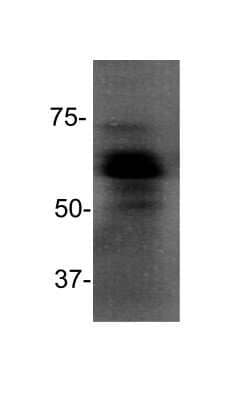Goat anti-Mouse IgG (H+L) Secondary Antibody [HRP] (Pre-adsorbed)
Novus Biologicals, part of Bio-Techne | Catalog # NB7570


Conjugate
Catalog #
Forumulation
Catalog #
Key Product Details
Species Reactivity
Mouse
Applications
ELISA, Immunoassay, Immunocytochemistry/ Immunofluorescence, Immunohistochemistry, Immunohistochemistry-Paraffin, Western Blot
Label
HRP
Antibody Source
Polyclonal Goat IgG
Format
Pre-adsorbed
Concentration
0.5 mg/ml
Product Specifications
Immunogen
This Goat anti-Mouse IgG (H+L) Secondary Antibody [HRP] (Pre-adsorbed) was developed against mouse IgG-heavy and light chain.
Reactivity Notes
Use in Monkey reported in scientific literature (PMID:33800884). Immunogen displays the following percentage of sequence identity for non-tested species: Bovine (85%).
Specificity
By immunoelectrophoresis and ELISA this Goat anti-Mouse IgG (H+L) Secondary Antibody [HRP] (Pre-adsorbed) reacts specifically with mouse IgG and with light chains common to other mouse immunoglobulins. No antibody was detected against non-immunoglobulin serum proteins. Antiserum was cross adsorbed using bovine, chicken, horse, human, pig and rabbit immunosorbents to remove cross reactive Antibodies. Less than 0.1% cross reactivity to bovine, chicken, goat, horse, human, pig and rabbit IgG was detected. This antibody may cross react with IgG from other species.
Clonality
Polyclonal
Host
Goat
Isotype
IgG
Scientific Data Images for Goat anti-Mouse IgG (H+L) Secondary Antibody [HRP] (Pre-adsorbed)
Western Blot: Goat anti-Mouse IgG (H+L) Secondary Antibody [HRP] (Pre-adsorbed) [NB7570] - Analysis of Jurkat cell lysate using anti-MBD1 antibody (Cat. # NB100-56537) followed by Goat anti-Mouse IgG (H+L) Secondary Antibody [HRP] (Pre-adsorbed). Image from verified customer review.
Applications for Goat anti-Mouse IgG (H+L) Secondary Antibody [HRP] (Pre-adsorbed)
Application
Recommended Usage
ELISA
1:10000-1:100000
Immunocytochemistry/ Immunofluorescence
1:200 - 1:5000
Immunohistochemistry
1:200 - 1:5000
Immunohistochemistry-Paraffin
1:200 - 1:5000
Western Blot
1:5000-1:50000
Application Notes
Use in Immunoassay reported in scientific literature (PMID:34944502)..
Reviewed Applications
Read 1 review rated 5 using NB7570 in the following applications:
Formulation, Preparation, and Storage
Purification
Immunogen affinity purified
Formulation
Phosphate Buffered Saline (PBS) containing 0.2%BSA
Format
Pre-adsorbed
Preservative
0.05% Pro-Clean 400
Concentration
0.5 mg/ml
Shipping
The product is shipped with polar packs. Upon receipt, store it immediately at the temperature recommended below.
Stability & Storage
Store at 4C. Do not freeze.
Background: IgG (H+L)
The 4 IgG subclasses, sharing 95% amino acid identity, include IgG1, IgG2, IgG3, and IgG4 for humans and IgG1, IgG2a, IgG2b, and IgG3 for mice. The relative abundance of each human subclass is 60% for IgG1, 32% for IgG2, 4% for IgG3, and 4% for IgG4. In an IgG deficiency, there may be a shortage of one or more subclasses (4).
References
1. Painter RH. (1998) Encyclopedia of Immunology (Second Edition). Elsevier. 1208-1211
2. Chapter 9 - Antibodies. (2012) Immunology for Pharmacy. Mosby 70-78
3. Schroeder H, Cavacini, L. (2010) Structure and Function of Immunoglobulins. J Allergy Clin Immunol. 125(2 0 2): S41-S52. PMID: 20176268
4. Vidarsson G, Dekkers G, Rispens T. (2014) IgG subclasses and allotypes: from structure to effector functions. Front Immunol. 5:520. PMID: 25368619
Additional IgG (H+L) Products
Product Documents for Goat anti-Mouse IgG (H+L) Secondary Antibody [HRP] (Pre-adsorbed)
Product Specific Notices for Goat anti-Mouse IgG (H+L) Secondary Antibody [HRP] (Pre-adsorbed)
This product is for research use only and is not approved for use in humans or in clinical diagnosis. Secondary Antibodies are guaranteed for 1 year from date of receipt.
